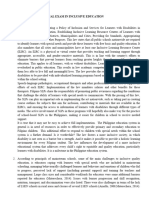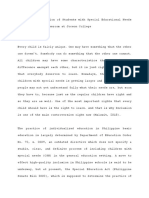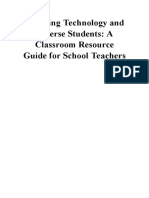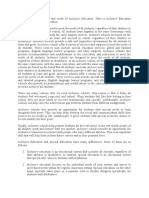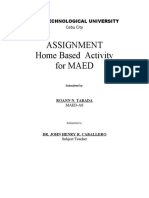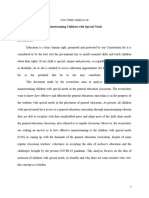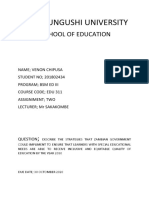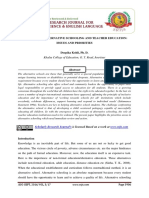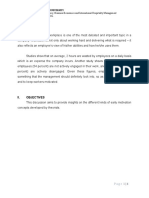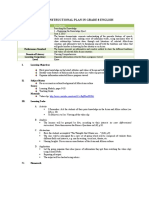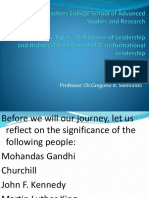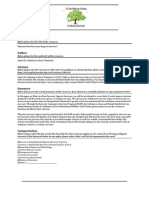Primary Special School
Primary Special School
Uploaded by
Mirzah JosonCopyright:
Available Formats
Primary Special School
Primary Special School
Uploaded by
Mirzah JosonOriginal Description:
Original Title
Copyright
Available Formats
Share this document
Did you find this document useful?
Is this content inappropriate?
Copyright:
Available Formats
Primary Special School
Primary Special School
Uploaded by
Mirzah JosonCopyright:
Available Formats
Name: Mirzah D.
Joson
Section: AR42FC1
Title: PROPOSED PRIMARY SPECIAL EDUCATION SCHOOL
Introduction
As the economy progresses in the Philippines, access on
needs and wants are within reach. For some it might still be difficult
because of poverty. But as the years passed, the lifestyle of the Filipino
people became more rampant. Based on National Statistics Offices data
on population, 1.43% of the national population are people with
disabilities. It is a drastic increase since 2010 therefore the government,
Department of Education provided programs that will accommodate the
needs of the people with disabilities. Since it is needed for the teachers to
be patient and able to motivate students, it requires a creative and
strategic types of teaching methods to reach students who are having
difficulty in learning. Communication and cooperation are essential traits
because special education teachers spend a great deal of time interacting
with others.
A Special Education school in the country will provide special
procedures with students with special needs. For the Philippine setting,
some small-scale special schools have integrated regular schooling so
that special students may adapt further on sociability. Special schools
should also provide clinical services like therapy and speech. Specialized
schools creates an opportunity for the students to be exposed and
involved in the community and can be beneficial to their achievement and
well-being, build stronger school relations, assist family connections, and
revitalize community environments. Quezon City, National Capital Region
topping the list of the number of people with disabilities, is ideal to be
the center of the development for Special Education school.
Learning environment also plays an important role for student
learning. In a special education classroom, it is designed to meet the
needs of the children which may composed of a reading area, play area,
one-on-one instruction, and other areas that can facilitate learning. In the
context of Special Education, being fair may come as providing the same
resources and facilities for the typically developing students and children
with disabilities but rather giving more attention and assistance to the
students with exceptionalities.
While decorations help create a warm environment,
organization of the furniture in the room is also important. There should be
enough space for all students to easily move throughout the classroom.
Teachers should consider the use of universal design. Universal design is
designing products and environments to be usable by all people, to the
greatest extent possible, without the need for modification or specialized
design (Bucholz & Steffler, 2009). The concepts of good classroom
design, listening skills, self-determination, and building class community
are transferable across the grade levels. These concepts are not just for
students with disabilities, but for all students. Building classroom
connections through these concepts can lead to student achievement
gains as has been demonstrated in research on school climate and
student achievement (Bucholz & Steffler, 2009).
In conclusion, education should not only be limited to people
who are abled. It does not mean that special children will not be able to
contribute to the welfare of the society. Each individual have a special
place in the society same as the special children. Hopefully in the future,
these special children will be recognized in their chosen fields in life.
school may serve as a new innovation in school buildings in the
Philippines. The location of the Special School is also significant because
Quezon City, part of the National Capital Region, have the greatest
percentage of people with disabilities based on National Statistics Offices
2010 Census.
Yearly, the Philippines have a significant number of backlogs
when it comes to the classrooms in public schools. Another problem that
may occur is the lack of social interaction for the students because of
minimal open space. Third is the limited facility for the special children.
Lastly, the design is not in accordance with the accessibility law.
Several methods have been proposed in order to have some
resolutions for these issues. Constructing a Specialized school will greatly
recognize the needs of the students with disabilities. Second is by
providing an open space so that it could help the children cope up with
sociability. Also, the project should consider the safety and accessibility of
the students.
However, most of the existing special schools do not cater
state-of-the-art immersive and interactive open spaces. Another is lack of
safety measure that would supposed to be the first consideration in
schools. Organization of classrooms are not in place. Another is the forced
integration of special students in public regular school. Lastly is the lack of
facilities that will aid the health and well-being of the special students.
In response to this, there might be a huge chance that there
will be dropped out students whether they are in regular or specialized
section. The whole environment in the school will not be conducive. As for
the immersive experience in the specialized school, there should be
interactive spaces but it turns out that it will be made for future
expansions.
Goals of the Project
The project focuses on nurturing the overall development of
each student, maximize his potentials and promote his independence and
skills through balanced and conducive environment that will allow him to
go into the world with a sense of purpose and confidence.
Project Objective
To provide a school that is conducive to learning and
ecologically safe
Statement of the Problem
To create a school that is with accordance with the
Accessibility Law
Building a Specialized School will greatly aid the children with
disabilities. Providing a large area for the students may help them in the
activities for social interaction. Creating a conducive and eco-friendly
To provide spaces that are immersive and cooperative to the
development of the students
You might also like
- Expert Learning For Law Students by Michael Hunter SchwartzDocument146 pagesExpert Learning For Law Students by Michael Hunter SchwartzDistilledMacrocosm100% (11)
- Research Paper: "A Proposed School For Special Children"Document19 pagesResearch Paper: "A Proposed School For Special Children"LarizOcliaso100% (1)
- National Reading Month Celebration Narrative ReportDocument5 pagesNational Reading Month Celebration Narrative Reportreiya92% (102)
- KSSMDocument33 pagesKSSMArrah Arrie100% (1)
- Inclusive Education AnswerDocument4 pagesInclusive Education AnswerClaudia BanicoNo ratings yet
- Final Exam (Research Seminar)Document9 pagesFinal Exam (Research Seminar)Bayaca Debbie100% (1)
- Output by Caira BernabeDocument4 pagesOutput by Caira BernabeCaira BernabeNo ratings yet
- The Various Facets of The Academe: A ReflectionDocument6 pagesThe Various Facets of The Academe: A ReflectionEmilio CarpioNo ratings yet
- Camila R. TabucolDocument112 pagesCamila R. TabucolKyzer Calix LaguitNo ratings yet
- Inclusive Education001Document2 pagesInclusive Education001khanbhaiNo ratings yet
- Inclusive Education: Concept, Need, Aims & ScopeDocument7 pagesInclusive Education: Concept, Need, Aims & ScopeArun A100% (3)
- Lesson 1 Inclusive Education in Special EducationDocument7 pagesLesson 1 Inclusive Education in Special Educationsinco lovelyn roseNo ratings yet
- Educ 2 CodillaDocument2 pagesEduc 2 CodillaHANNAH LOUISE CODILLANo ratings yet
- Chapter SummeriesDocument5 pagesChapter Summeriesapi-316337024No ratings yet
- Unit 3 Making School InclusiveDocument26 pagesUnit 3 Making School InclusiveumoquitquengelNo ratings yet
- Educational Technology For Inclusive Classroom Sumana PaulDocument10 pagesEducational Technology For Inclusive Classroom Sumana PaulAnonymous CwJeBCAXpNo ratings yet
- What Is National Curriculum Framework (NCF 2005) ?Document6 pagesWhat Is National Curriculum Framework (NCF 2005) ?chamaNo ratings yet
- Webquest PozdniakovaDocument6 pagesWebquest PozdniakovaAlina PozdnyakovaNo ratings yet
- Lesson 1cDocument7 pagesLesson 1cRonnelNo ratings yet
- Inclusive EducationDocument5 pagesInclusive Education11th commerceNo ratings yet
- 1) The Opportunities and Teacher Challenges To Overcome Inequality in Educational OpportunitiesDocument5 pages1) The Opportunities and Teacher Challenges To Overcome Inequality in Educational OpportunitiesKanageswary SaiNo ratings yet
- Educ-207 Chapter 2 ActivityDocument5 pagesEduc-207 Chapter 2 ActivityRegine BarramedaNo ratings yet
- Incomplete ResearchDocument12 pagesIncomplete ResearchHANNALEI NORIELNo ratings yet
- Inclusive Education in The Philippine1Document4 pagesInclusive Education in The Philippine1Rosalie DomingoNo ratings yet
- AmorDocument21 pagesAmorjacl26372No ratings yet
- The Partial Inclusion of Students With Special Educational Needs in The Regular Classroom at Jocson CollegeDocument5 pagesThe Partial Inclusion of Students With Special Educational Needs in The Regular Classroom at Jocson CollegeLilet ManaloNo ratings yet
- MITWGS 693S09 Sw02 LearningDocument12 pagesMITWGS 693S09 Sw02 LearningRaj MohapatraNo ratings yet
- Addressing Learning Gaps SummaryDocument3 pagesAddressing Learning Gaps SummaryFloravie Onate67% (3)
- Group2 SpinelDocument18 pagesGroup2 SpinelarlenemarieamuraoNo ratings yet
- Classroom - Feb 17, 2022 at 8:56 AMDocument4 pagesClassroom - Feb 17, 2022 at 8:56 AMAremshakeNo ratings yet
- Foundation of Special and Inclusive Education - Topic 01pptxDocument30 pagesFoundation of Special and Inclusive Education - Topic 01pptxvanessa patriarcaNo ratings yet
- Changing Teaching Practices Using Curriculum Differentiation To Respond To Students' DiversityDocument109 pagesChanging Teaching Practices Using Curriculum Differentiation To Respond To Students' Diversityfrankoppong100% (1)
- Primary SchoolDocument8 pagesPrimary SchoolDigonta AhmedNo ratings yet
- Question Bank 2021Document7 pagesQuestion Bank 2021WangnaoNo ratings yet
- Recent Trends in Education of Children With Intellectual DisabilityDocument6 pagesRecent Trends in Education of Children With Intellectual DisabilityShilpa ManognaNo ratings yet
- Concept NoteDocument3 pagesConcept NoteYatin BehlNo ratings yet
- Lsen - Reaction PaperDocument4 pagesLsen - Reaction PaperRhoda Gemillan GamboaNo ratings yet
- Qualitative Researchzxczxczxc1Document23 pagesQualitative Researchzxczxczxc1Francis DoronNo ratings yet
- Educ 402 ExamDocument3 pagesEduc 402 ExamJose Venus JrNo ratings yet
- Explain The Social Factors That Affect Learning in The ClassroomDocument4 pagesExplain The Social Factors That Affect Learning in The ClassroomJane HembraNo ratings yet
- Assignment Home Based Activity For MAED: Cebu Technological University Cebu CityDocument14 pagesAssignment Home Based Activity For MAED: Cebu Technological University Cebu CityZurchiel LeihcNo ratings yet
- Assign em NTDocument4 pagesAssign em NTMacowzaNo ratings yet
- Case Study Analysis On Mainstreaming CSNDocument12 pagesCase Study Analysis On Mainstreaming CSNSherwin AlarcioNo ratings yet
- Wbuttepa Bed Guide LineDocument13 pagesWbuttepa Bed Guide Linebareh jamesNo ratings yet
- RationaleDocument56 pagesRationaleWinnie LaraNo ratings yet
- Draft Madam LizaDocument8 pagesDraft Madam LizaecahNo ratings yet
- Quality EducationDocument9 pagesQuality EducationArun Kumar SinghNo ratings yet
- Bachelor of Technical Vocational Teaching Education 1 1Document8 pagesBachelor of Technical Vocational Teaching Education 1 1Joan Dela Cruz IsipNo ratings yet
- EDU 311 Assignment TwoDocument6 pagesEDU 311 Assignment Twovenon chipusaNo ratings yet
- 6 Deepak KohaliDocument6 pages6 Deepak KohaliAnonymous CwJeBCAXpNo ratings yet
- ReflectionDocument5 pagesReflectionJessiah Jade LeyvaNo ratings yet
- Edfd261 Assignment 2Document7 pagesEdfd261 Assignment 2api-253728480No ratings yet
- Moving Towards Greater Inclusion in Singapores PRDocument16 pagesMoving Towards Greater Inclusion in Singapores PRFikri OthmanNo ratings yet
- Sociological Foundations of Education - Reflection NoteDocument27 pagesSociological Foundations of Education - Reflection NoteFRANCIS IBANITANo ratings yet
- Oumh1203 English For Written CommunicationDocument15 pagesOumh1203 English For Written CommunicationAtikah IzzatiNo ratings yet
- Sen Unit PatanaDocument6 pagesSen Unit Patanaapi-312587452No ratings yet
- Beyond the Classroom: Unconventional Education for a Changing WorldFrom EverandBeyond the Classroom: Unconventional Education for a Changing WorldNo ratings yet
- Classroom-Ready Resources for Student-Centered Learning: Basic Teaching Strategies for Fostering Student Ownership, Agency, and Engagement in K–6 ClassroomsFrom EverandClassroom-Ready Resources for Student-Centered Learning: Basic Teaching Strategies for Fostering Student Ownership, Agency, and Engagement in K–6 ClassroomsNo ratings yet
- Transformational Teaching: The Key <Br>To Authentic <Br>School ImprovementFrom EverandTransformational Teaching: The Key <Br>To Authentic <Br>School ImprovementNo ratings yet
- Classroom Language Test-SDocument31 pagesClassroom Language Test-SMenekşe MenekNo ratings yet
- Fs 2 Experiencing The Teaching-Learning ProcessDocument29 pagesFs 2 Experiencing The Teaching-Learning Processkakatuwa71% (7)
- Communicative Teaching - Advantages and DisadvantagesDocument1 pageCommunicative Teaching - Advantages and DisadvantagesDelia Cristea100% (1)
- Relationship of Education and Psychology, Contributions of The Following Schools of Psychology To EducationDocument4 pagesRelationship of Education and Psychology, Contributions of The Following Schools of Psychology To EducationRicardo JabileNo ratings yet
- Narrative ReportDocument6 pagesNarrative ReportKristine BelgadoNo ratings yet
- Interpretation of Discrimination Data From Multiple-Choice Test ItemsDocument4 pagesInterpretation of Discrimination Data From Multiple-Choice Test ItemsFayza Nashrillah KimNo ratings yet
- David Case ConceptuatlizationDocument6 pagesDavid Case Conceptuatlizationapi-289842236No ratings yet
- Planeamiento de Inglés - English Lessons Planning Costa RicaDocument30 pagesPlaneamiento de Inglés - English Lessons Planning Costa RicaOmega Ovnis Ufos100% (6)
- Designing Action-Oriented Tasks For Primary and Junior Core French - Presentation HandoutDocument5 pagesDesigning Action-Oriented Tasks For Primary and Junior Core French - Presentation Handoutapi-282728029No ratings yet
- Motivation Is The Driving Force Which Causes Us To Achieve GoalsDocument5 pagesMotivation Is The Driving Force Which Causes Us To Achieve GoalsTiron Razz SennNo ratings yet
- Expository Essay Pros and ConsDocument2 pagesExpository Essay Pros and ConsMary Cassey Golosino Devibar IINo ratings yet
- Assessment & Management of Dissociative Disorders: Chairperson: DR - Safeekh A.T. Presenter: Dr.D.ArchanaaDocument62 pagesAssessment & Management of Dissociative Disorders: Chairperson: DR - Safeekh A.T. Presenter: Dr.D.Archanaadrkadiyala2No ratings yet
- Lesson 6 Sound and LightDocument5 pagesLesson 6 Sound and Lightapi-337406556No ratings yet
- Running Head: The Visual Learner 1Document4 pagesRunning Head: The Visual Learner 1Damonta HenryNo ratings yet
- Lesson Plan The Six Blind Men and The ElephantDocument4 pagesLesson Plan The Six Blind Men and The ElephantAlejandraCastañedaNo ratings yet
- Motivation For Reading (MRQ)Document24 pagesMotivation For Reading (MRQ)Yarre Rosli100% (3)
- Schizophrenia in Old AgeDocument21 pagesSchizophrenia in Old AgeAyedh TalhaNo ratings yet
- Upstanders and Allies: Taking Action Against Cyberbullying: Digital Citizenship - Grade 7Document9 pagesUpstanders and Allies: Taking Action Against Cyberbullying: Digital Citizenship - Grade 7Tina ClarkNo ratings yet
- Sample Instructional Plan in Grade 8 English: Theme Lesson Date Content StandardDocument1 pageSample Instructional Plan in Grade 8 English: Theme Lesson Date Content StandardCharm LumampaoNo ratings yet
- Professor: DR - Gregorio R. SismondoDocument38 pagesProfessor: DR - Gregorio R. Sismondomarlou agustinNo ratings yet
- Dark TriadeDocument31 pagesDark Triadefabio patonNo ratings yet
- Lesson PlanDocument5 pagesLesson PlanGrachelle Janette Hidalgo ValienteNo ratings yet
- Student Teaching Placement 1 Lesson Plan 1Document4 pagesStudent Teaching Placement 1 Lesson Plan 1api-264021425100% (1)
- What Are Peer Recovery Support Services?Document17 pagesWhat Are Peer Recovery Support Services?The Stacie Mathewson FoundationNo ratings yet
- Who MC Topic-2Document34 pagesWho MC Topic-2pkvlaserNo ratings yet
- FS 1 Syllabus-EditedDocument7 pagesFS 1 Syllabus-EditedMyrene Sarmiento100% (4)
- Teacher ResourcesDocument6 pagesTeacher Resourcesapi-417822696No ratings yet




